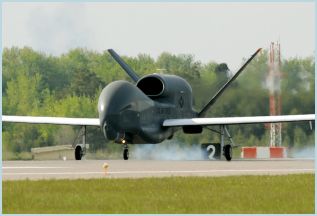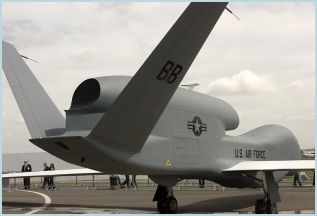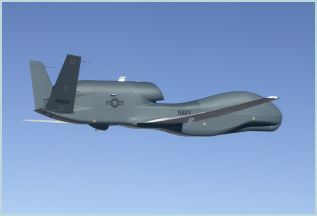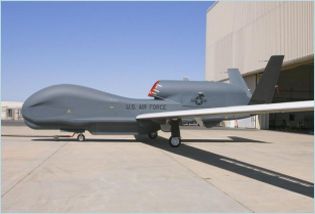RQ-4 Global Hawk
| a | ||||||||||||||||||||||
|
RQ-4A/B Global Hawk High-Altitude Long-Endurance HALE Unmanned Aerial System
|
||||||||||||||||||||||
|
|
||||||||||||||||||||||
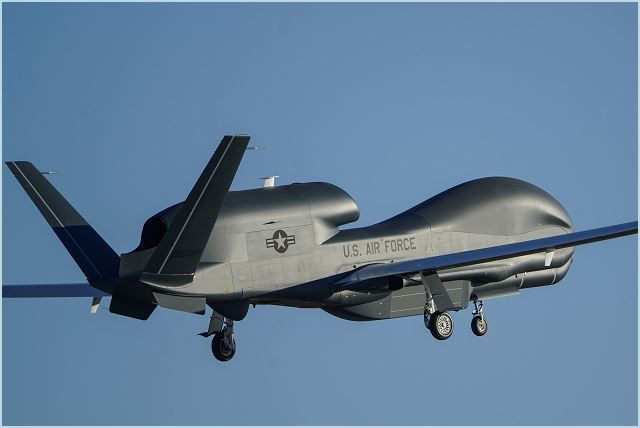 |
||||||||||||||||||||||
|
|
||||||||||||||||||||||
|
The RQ-4 Global Hawk is a high-altitude, long-endurance, remotely piloted aircraft with an integrated sensor suite that provides global all-weather, day or night intelligence, surveillance and reconnaissance (ISR) capability. Global Hawk is produced by US manufacturer Northrop Grumman and has its origins in the 1995 High-Altitude Endurance Unmanned Aerial Vehicle Advanced Concept Technology Demonstration (HAE UAV ACTD) program initiated by the Defense Advanced Research Projects Agency (DARPA) and the Defense Airborne Reconnaissance Office (DARO). The Global Hawk took its first flight on 28 February 1998. The Global Hawk effort succeeded because it focused on the design and construction of a practical air vehicle that was developmentally mature enough to be transitioned into an operational weapons system. While still a developmental system, the Global Hawk system began supporting overseas contingency operations only two months after the September 11, 2001 attacks. The system has surpassed 125,000 flight hours and midway through 2014 had 100,000 combat/operational flight hours.
Global Hawk is currently fielded in three distinct blocks. Seven Block 10 aircraft were procured, but were retired from the US Air Force inventory in 2011. Northrop Grumman developed RQ-4B, which has a 50% payload increase, larger wingspan (39.9 m) and longer fuselage (14.5 m), and new generator to provide 150% more electrical output. Three RQ-4B air vehicles (block 20) were initially ordered plus a further five ordered in November 2005. Block 20 aircraft also have an upgraded sensor suite. Block 20s were initially fielded with IMINT-only capabilities, but three Block 20s have been converted to an EQ-4 communication relay configuration, carrying the Battlefield Airborne Communication Node (BACN) payload. Block 30 is a multi-intelligence platform that simultaneously carries electro-optical, infrared, synthetic aperture radar (SAR), and high and low band SIGINT sensors. Block 30 Initial Operating Capability (IOC) was declared in August 2011. Eighteen Block 30s are currently fielded, supporting every geographic combatant command as well as combat missions in Operations Enduring Freedom and Iraqi Freedom/ New Dawn. Block 30s also supported Operation Odyssey Dawn in Libya and humanitarian relief efforts during Operation Tomodachi in Japan. Block 40 carries the Radar Technology Insertion Program (RTIP) active electronically scanned array radar which provides MTI and SAR data. Block 40 Early Operating Capability (EOC) was declared in September 2013 and eleven Block 40s are currently fielded, supporting operations in four combatant commands. IOC is projected in 2015. The Global Hawk RQ-4 and its variants are actually only in use in the US Air Force (33 units in active duty in October 2014). In December 2007, two Global Hawks were transferred from the U.S. Air Force to NASA's Dryden Flight Research Center at Edwards Air Force Base. Moreover, many potential operators have expressed interest in purchasing the RQ-4 Global Hawk: Australia, Canada, Japan, Spain, New-Zealand and India. On 17 December 2014, Northrop Grumman was officially awarded a contract worth over $657 million to provide South Korea with four RQ-4B Block 30 Global Hawks with all to be delivered by June 2019. |
||||||||||||||||||||||
| Variants | ||||||||||||||||||||||
| RQ-4A Global Hawk: initial serie | ||||||||||||||||||||||
| RQ-4B Global Hawk Block 20: have an upgraded sensor suite with IMINT-only capabilities, three Block 20 converted to an EQ-4 communication relay configuration, carrying the Battlefield Airborne Communication Node (BACN) payload | ||||||||||||||||||||||
| RQ-4 Global Hawk Block 30: multi-intelligence platform that simultaneously carries electro-optical, infrared, synthetic aperture radar (SAR), and high and low band SIGINT sensors | ||||||||||||||||||||||
| Technical Data | ||||||||||||||||||||||
| Design | ||||||||||||||||||||||
|
The RQ-4 Global Hawk is a high-altitude, long-endurance, remotely piloted aircraft with an integrated sensor suite that provides global all-weather, day or night intelligence, surveillance and reconnaissance (ISR) capability. The Global Hawk system consists of the RQ-4 air vehicle; mission control element (MCE) with two workstations for a pilot and a sensor operator crew; launch and recovery element (LRE) also operated by pilot with his workstation acting as the cockpit; a wide variety of sensors; command and control links covering health and status of the aircraft, sensors, navigational systems and communication links; support element; and trained personnel. Global Hawk, which has a wingspan of 39.8 m, is 14.5 meters long and 4.7 m height.
|
||||||||||||||||||||||
|
Mobility
|
||||||||||||||||||||||
|
The Global hawk is powered by a single Rolls-Royce AE 3007H Turbofan engine with 8,600 pounds of thrust, specifically developed for the Global Hawk program is a growth version of the AE3007 engine, currently in use in the Citation X and the Embraer Regional Jet. The Rolls-Royce AE 3007 (military designation F137) is an 8,600-pound class high-bypass two-spool turbofan engine featuring a wide-chord single-stage low-pressure compressor, a 14-stage high pressure compressor followed by an effusion-cooled annular combustor, a two-stage high-pressure turbine, and a three-stage low-pressure turbine. The AE 3007H is derived from the AE 1107C-Liberty turboshaft engine used on the Bell Helicopter Textron/Boeing V-22 Osprey. It was initially developed to create a turbofan member of the AE common core family for the regional jet and medium/large business jet markets but has subsequently been developed for military aircraft applications. A single AE 3007H engine allows the Northrop Grumman RQ-4 Global Hawk to fly at an altitude of max. 19,812 m while providing over 32 hours of real-time mission imagery to battlefield commanders. The system has proven itself in the skies over Afghanistan and Iraq. The RQ-4 can range as far as 22,780 km and fly at speeds approaching 574 km/h.
|
||||||||||||||||||||||
|
Payload equipment
|
||||||||||||||||||||||
|
The RQ-4 Block 20 features a communications relay payload, the now cancelled Block 30 features a multi intelligence suite for imagery and signals intelligence collection. The RQ-4 Block 40 aircraft provides a new generation of surveillance capability to monitor large areas in all weather. The Global Hawk Block 40 is equipped with the AN/ZPY-2 multi-platform radar technology insertion program (MP-RTIP) Active Electronically Scanned Array (AESA) radar, which is an advanced air-to-surface radar for wide area surveillance of fixed and moving targets. The MP-RTIP sensor allows military commanders to gather near real-time imagery of moving targets. The RQ-4B Block 40 is also equipped with Synthetic Aperture Radar (SAR) “Spot and Swath” Imagery for fixed targets; a Ground Moving Target Indicator (GMTI) for moving objects; Wideband Ku SATCOM and line-of-sight connectivity for communication purposes; ground servers store data for worldwide network access and data storage. The Global Hawk is equipped with a Hughes Integrated Surveillance & Reconnaissance (HISAR) sensor system. HISAR is a lower-cost derivative of Raytheon Company's ASARS-2 package, which Hughes Electronics (now part of Raytheon) developed for the Lockheed U-2 Dragon Lady spyplane.
|
||||||||||||||||||||||
| Combat use | ||||||||||||||||||||||
|
Global Hawk's mission is to provide a broad spectrum of ISR collection capability to support joint combatant forces in worldwide peacetime, contingency and wartime operations. The Global Hawk provides persistent near-real-time coverage using imagery intelligence (IMINT), signals intelligence (SIGINT) and moving target indicator (MTI) sensors. Global Hawk can carry out reconnaissance missions in all types of operations. The 22,780 km range and 32-hour endurance of the air vehicle, combined with satellite and line-of-sight communication links to ground forces, permits worldwide operation of the system. High-resolution sensors, including visible and infrared electro-optical systems and synthetic aperture radar, will conduct surveillance over an area of 40,000nm² to an altitude of 19.8 km in 24 hours.
|
||||||||||||||||||||||
| Specifications | ||||||||||||||||||||||
|
||||||||||||||||||||||
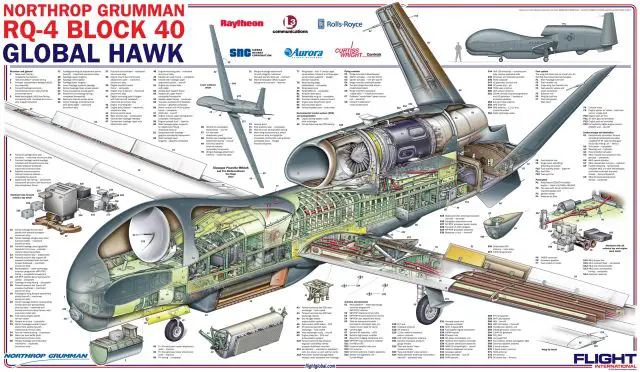 |
||||||||||||||||||||||
|
||||||||||||||||||||||



























